Summary: In this Article, you’ll get to read about —
Roulette, the bewitching Queen of the casino floor, has been occupying the minds of mathematicians and physicists for decades. The numerical beauty of the game and its imperceptible equilibrium have been encouraging them to count and recount probabilities, measure the speed and the centrifugal force of the wheel, build tiny inside-the-shoes computers and develop one betting strategy after another.
Even though beating the cunning wheel more often than being beaten by it is still up for discussion, scientific persistence has brought us a couple of Roulette strategies.
Before we begin, we would like to put the record straight. Although these systems have plenty of sensible ideas and a scientific base behind them, the strategies we are going to talk about here are not a 100% guarantee of life-changing cash prizes and accurate picks of winning numbers at Roulette. They are not the cheat sheets that will help you solve all the gamblers’ problems and avoid uncertainties. Stay realistic and look at these systems as the guidelines to understand the game and its odds deeper, control the gambling process and manage the budget.
Martingale
The Martingale strategy is the most popular Roulette strategy. It is very easy to understand and hard to implement at a real casino table.
The formula is simple: double each bet you lose and bet the same amount after a win. The idea is to compensate for all the previous losses with only one successful bet. And, yes, according to the math, on paper, your losses will all be returned. But how about playing the strategy out in real life?
We called the strategy hard to follow because it requires a substantial budget and a mental ability to stick to the plan even during a long losing streak. Watching your hundred dollars disappearing and doubling the bet next time nevertheless – are you sure that you will be able to do it?
Here is what a sequence of 10 Roulette bets will look like if you apply the Martingale strategy and start with a $5 stake: $5 – $10 – $20 – $40 – $80 – $160 – $320 – $640 – $1280 – $ 2560.
We are not saying that you shouldn’t use the Martingale system ever in your life; just be realistic. Maybe, try it on outside bets with almost 50/50 winning chances – bet on Odd/Even, High/Low, Red/Black, for instance – and stay in control of your head and emotions.
Fibonacci
The Martingale strategy is based on negative progression (which means increasing stakes after a loss), and so is the Fibonacci system. It follows the same concept: one successful bet will compensate for all the losses. The main difference, as well as the reason why most gamblers consider the latter a safer approach, is that the increasing curve will not be so steep as with doubling the bets. Consequently, the system will not require unreasonably high bankrolls.
It is strongly advised to apply the Fibonacci strategy to even-money bets only (Odd/Even, High/Low, Red/Black).
Some of you have probably heard of the Fibonacci numbers sequence, also known as the ‘Nature’s universal rule’. Correlations of the Fibonacci numbers are found in arrangements of tree branches and Nautilus spirals, in the Golden ratio, and so on.
In the Fibonacci sequence, each number equals the sum of 2 previous numbers: 0 – 1 – 1 – 2 – 3 – 5 – 8 – 13 – 21 – 34 – 55 – 89 – 144, etc…
What a Roulette player will need to do with it is to follow the sequence of bet sizes (1 – 1 – 2 – 3 – 5 – 8 – 13…) until the first win. After that, they have to go 2 steps back in the sequence and continue playing from that point. For example, if you win on the 6ths step – after betting $8 – your next bet will be $3 again.
D’Alembert
Like the 2 approaches we’ve already described, the D’Alembert strategy is a negative progression as well and will work best with even-money bets. It is more bearable than the Martingale system in terms of bankroll size.
For implementing the strategy, follow the four steps:
- determine the ‘base unit’ – the amount of money (shouldn’t be too big) that will be added or subtracted from your bet depending on the outcome of each spin;
- the first bet you place must equal the base unit;
- if you lose, your next bet = your previous bet + the base unit;
- if you win, your next bet = your previous bet – the base unit.
Let’s see how it will work with a $2 base unit.
$2 (lost) – $4 (lost) – $6 (lost) – $12 (won) – $10 (lost) – $12…
We would suggest anyone who decides to gamble Roulette for real money, however confident they are in everything they’ve read up on the matter, to try playing the game somewhere for free or with minimal risks. Most online casinos provide demo versions of their games, and Roulette is usually on the list. The other options for boosting your game knowledge are video tutorials, online streams, blogs, casino tournaments, and forums.
You can also read to know: How NFTs are Helping Streamers?
Don’t go to a real-money casino unprepared or with theoretical knowledge only: you will have to learn on your feet and pay for it.



